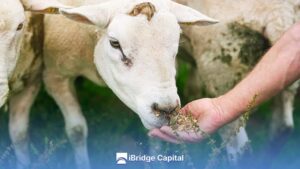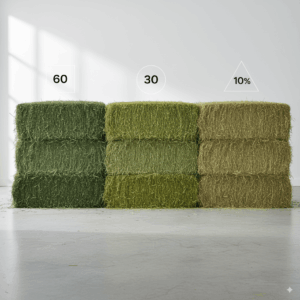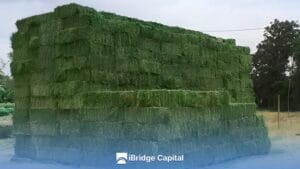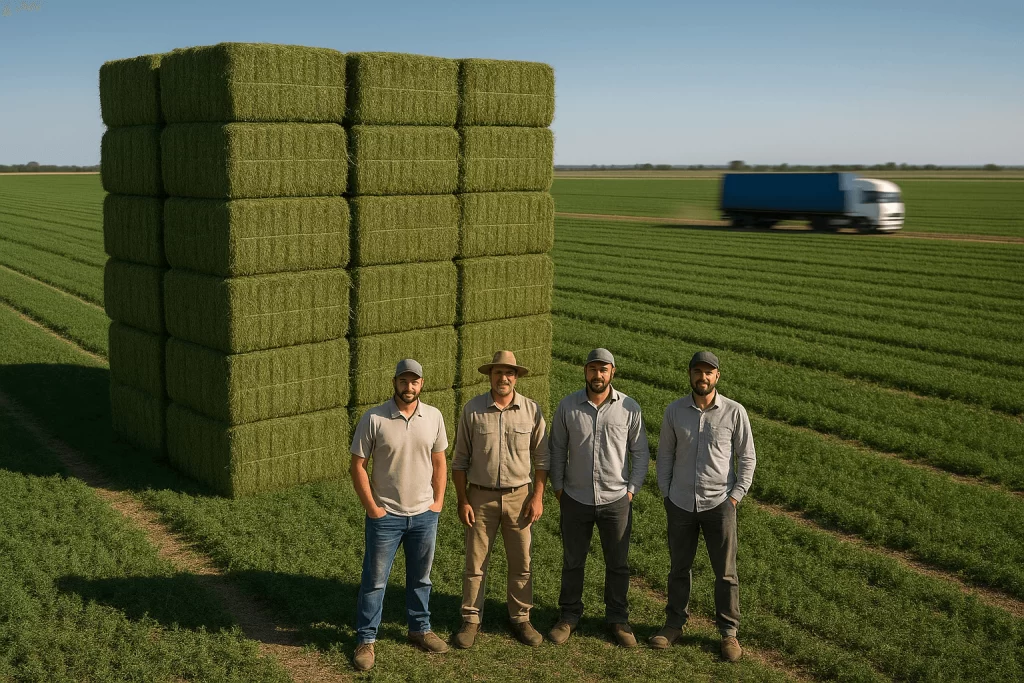Key Elements in Mega-Bale Production
Choosing the Right Cutting Time
Alfalfa mega-bale production is a practice that has gained ground in the field, and for good reason. It represents an efficient way to preserve forage, but its success depends on several crucial factors.
One of the most important is the exact moment you decide to cut the alfalfa. It’s not just a matter of calendar, but of observing the plant and the weather conditions.
To achieve exceptional alfalfa mega-bale quality, cutting must be done at the optimal stage of plant maturity. This is usually when the alfalfa has between 10% and 20% flowering.
At this stage, the leaf-to-stem ratio is ideal, ensuring high alfalfa mega-bale nutritional value. If you cut too early, dry matter production will be lower; if you delay, fiber will increase and protein will decrease, affecting digestibility.
The alfalfa mega-bale process begins with this precise cut. The decision is also influenced by the weather forecast. You need sunny, dry days for the alfalfa to lose moisture uniformly in the field.
Essential Machinery for Mega-Bales
To carry out alfalfa mega-bale production efficiently, having the right machinery for alfalfa mega-bales is essential. We’re not just talking about the baler, but a whole set of equipment for mega-bales that work in sync.
This includes self-propelled mowers that cut and “condition” the alfalfa for faster drying, rakes that group the forage, and of course, mega-balers.
Mega-balers are the heart of this system. There are different types of balers for mega-bales, from those that produce lower-density bales to high-compaction ones. The choice will depend on your production scale and your objectives.
Some producers, especially smaller ones, might consider used machinery for mega-bales as a viable alternative to reduce initial investment, provided a thorough technical review is performed.
Operational and Economic Advantages of Mega-Bales
Optimization of Storage and Transport
One of the great advantages of alfalfa mega-bales is space optimization. If you’ve wondered what is an alfalfa mega-bale?, think of a highly compacted block of forage, much denser than a conventional bale or roll.
This translates into amazing efficiency for alfalfa mega-bale storage. You can stack more forage in the same space, which reduces the need for large sheds and protects your investment from the elements.
The comparison of bales and mega-bales is clear on this point. A mega-bale can contain the same amount of forage as several small bales or rolls, but occupying a fraction of the volume. This not only saves space in your field or shed but also has a direct impact on alfalfa mega-bale transport.
By being able to load more forage per truck, alfalfa mega-bale costs related to logistics are significantly reduced. A truck that previously carried 10 rolls can now carry 20 mega-bales, doubling the payload and reducing trips.
More Efficient Field Management
Mega-bale field management is another aspect where the benefits of mega-bales are noticeable. Their uniform size and shape facilitate the use of specialized machinery for their collection and stacking. Unlike rolls, which can be more difficult to handle on uneven terrain, mega-bales adapt well to automated loading and unloading systems.
Knowing how to load mega-bales? efficiently is key to maximizing their advantages. Front loaders or telescopic handlers with special clamps are used to move large volumes of forage safely and quickly. Similarly, how to stack mega-bales? correctly is vital for mega-bale preservation.
It is recommended to stack them in a pyramid or well-organized rows, on a dry base and protected from moisture.
Alfalfa mega-bale production is not only efficient in the field but also impacts animal feeding. The ease of supply and dosing in feeders reduces waste. This contributes to alfalfa mega-bale profitability by ensuring that every kilo of forage produced is consumed by animals, optimizing the investment in cultivation and machinery.
Ensuring Forage Quality
The Importance of Ideal Moisture
Alfalfa mega-bale quality is the most important factor that will determine its market value and its impact on animal feeding. And at this point, ideal moisture for mega-bales is key. If alfalfa is baled with too much moisture, there is a risk of fermentation, heating, and fungal growth, which degrades the forage and can even create fire hazards.
On the other hand, if it’s too dry, the leaves, which are the most nutritious part, detach and are lost during the process.
Drying alfalfa for mega-bales is a critical step. Although most mega-bales are produced from field-cured alfalfa, i.e., sun-dried, constant moisture monitoring is essential.
Portable moisture meters are used to ensure the forage reaches the appropriate level, generally between 12% and 18% moisture, before being baled. This rigorous control is what differentiates a high-quality mega-bale from a mediocre one.
Superior Nutritional Value in Mega-Bales
The benefits of mega-bales are directly reflected in the alfalfa mega-bale nutritional value. Thanks to rapid haymaking and high compaction, leaf loss is minimized, and key nutrients, such as protein and energy, are preserved.
This is especially important for haymaking in mega-bales, as the goal is to obtain forage that contributes significantly to animal diets.
Performing an alfalfa mega-bale analysis regularly is a recommended practice. This allows you to know the exact composition of your forage (crude protein, fiber, energy) and thus offer a guaranteed product. Buyers, especially those who feed high-performance animals, highly value this information.
A mega-bale with a high protein content, for example, can reduce the need for expensive supplements in the animal diet.
Cost Analysis and Return on Investment
Breaking Down the Initial Investment
When considering alfalfa mega-bale production, one of the first questions that arises is: how much does an alfalfa mega-bale cost? But before getting to the cost per unit, it’s essential to understand the necessary initial investment.
This includes the acquisition of machinery for alfalfa mega-bales, which, as mentioned, ranges from the mower to the baler. The price of these machines can vary considerably depending on the brand, model, and whether they are new or used machinery for mega-bales.
In addition to the cost of equipment for mega-bales, you must consider land preparation, alfalfa planting, and initial inputs (seeds, fertilizers, agrochemicals). Although the latter are part of the operational alfalfa mega-bale costs, the investment in the crop itself is a significant initial component.
For many producers, alfalfa mega-bale profitability is evaluated over several years, as alfalfa is a perennial crop that can offer multiple cuts per season during its alfalfa mega-bale lifespan in the field.
Projecting Profits with Mega-Bales
Alfalfa mega-bale profitability becomes evident when comparing income with alfalfa mega-bale costs. Mega-bales, being a higher quality and more efficient product to handle, usually sell at a higher price per ton than traditional hay.
If you’re wondering how many mega-bales does one hectare yield?, the answer will depend on several factors such as the alfalfa variety, climatic conditions, fertilization, and crop management. An average yield in good conditions can be 10 to 15 tons of dry matter per hectare per year, distributed over several cuts.
Consider an example: if you produce 12 tons of alfalfa per hectare per year in mega-bales, and the selling price is $150 per mega-bale (assuming a weight of 500 kg), your gross income per hectare would be significant.
Subtracting the alfalfa mega-bale costs (machinery, fuel, labor, inputs), you will get your profit margin. The economic advantages of mega-bales are enhanced by reducing deterioration losses and optimizing transport, which increases the volume of sellable products.
The Role of Mega-Bales in Animal Feeding
Their Impact on Modern Livestock Farming
The use of mega-bales in livestock farming has revolutionized the way many producers feed their animals. Their high compaction and preservation of nutritional quality make them a very efficient forage source. For intensive production systems, where dietary precision is key, mega-bales are an ideal solution.
Alfalfa mega-bale production allows livestock farmers to have high-quality feed available throughout the year, regardless of climatic conditions. This is vital for maintaining consistent milk or meat production. By having a guaranteed alfalfa mega-bale nutritional value, nutritionists can formulate more precise diets, optimizing animal performance and reducing feed waste.
Furthermore, the benefits of mega-bales extend to animal health. Good quality forage, free of fungi and with adequate moisture, prevents digestive and respiratory problems. This translates into fewer veterinary expenses and more robust animals.
Specific Uses for Different Species
Alfalfa mega-bales are versatile and adapt to the needs of various animal species. For dairy producers, alfalfa mega-bales for cattle are an excellent source of protein and fiber, essential for high milk production. Their consistency and quality contribute to ration stability.
In the case of equines, alfalfa mega-bales for horses are highly valued. Alfalfa is a high-energy and protein forage, ideal for sport horses, pregnant or lactating mares, and growing foals. The high alfalfa mega-bale quality ensures that horses receive clean, nutritious feed, minimizing dust and allergens that can affect their respiratory system.
Although less common, alfalfa mega-bales for sheep can also be an option, especially for high-performance flocks or during periods of pasture scarcity. The key lies in diet formulation and ration size, as sheep have specific requirements.
Strategies for Marketing Mega-Bales
The Local Market and Its Opportunities
Once you’ve mastered alfalfa mega-bale production, the next step is marketing. The local market offers significant opportunities, especially if you focus on customers who value quality and convenience. This includes dairy farms, feedlots, horse breeders, and sheep or goat producers looking for high-quality forage for their animals.
To sell your mega-bales, it’s helpful to do an alfalfa mega-bale analysis for your customers. This means you can offer them detailed information about the nutritional composition of your forage, allowing them to make informed decisions about their animals’ diets. Transparency builds trust and can differentiate you from the competition.
Alfalfa mega-bale profitability is maximized when you manage to establish long-term relationships with your customers. Offering a consistent product and reliable service will help you build a solid reputation in the local market.
Export Potential of Mega-Bales
The export potential of mega-bales is immense and represents one of the greatest economic advantages of mega-bales. Countries with arid climates or with a strong livestock industry and limited forage production, such as Saudi Arabia, China, or Japan, are major importers of high-quality dehydrated alfalfa.
Alfalfa mega-bale production with the appropriate standards opens doors to these markets.
The comparison of bales and mega-bales is especially relevant in international trade. The high alfalfa mega-bale density allows for optimizing space in shipping containers, drastically reducing alfalfa mega-bale transport costs over long distances.
This makes the product more competitive in the global market. For example, a container that previously carried 20 tons of hay in rolls can now carry 25 or 28 tons in high-density mega-bales.
Countries like alfalfa mega-bales in Argentina, alfalfa mega-bales in Chile, alfalfa mega-bales in Spain, and alfalfa mega-bales in Mexico are already participating in this market, demonstrating the viability of export.
Common Challenges and Practical Solutions
Avoiding Problems in the Process
Despite the advantages of alfalfa mega-bales, alfalfa mega-bale production is not without its challenges. One of the most common problems in mega-bale production is moisture. If alfalfa is baled with an incorrect moisture level, it can heat up, mold, or even spontaneously combust.
The solution lies in constant monitoring of the ideal moisture for mega-bales and proper drying alfalfa for mega-bales in the field.
Another challenge is leaf loss during the alfalfa mega-bale process. Leaves are the most nutritious part, and their detachment reduces alfalfa mega-bale quality. To minimize this, it’s crucial to operate the machinery for alfalfa mega-bales at the right speed and avoid over-drying.
Haymaking in mega-bales must be a delicate process to preserve the plant’s integrity.
Mega-bale handling safety is also a vital aspect. Due to their weight and size, alfalfa mega-bale transport and stacking require caution and the use of appropriate equipment.
Tips for Long-Term Preservation
Mega-bale preservation is as important as their production. Once mega-bales are made, their proper alfalfa mega-bale storage is crucial to maintain their alfalfa mega-bale lifespan and quality. Ideally, they should be stored indoors, on a dry surface (pallets or skids), and well-ventilated, to avoid contact with ground moisture and condensation.
If you don’t have sheds, you can consider using special plastic covers to protect the mega-bales from rain and sun. However, it’s important to ensure good ventilation to prevent moisture buildup. The future of mega-bale production also involves innovations in storage, such as real-time temperature and moisture monitoring systems.
Finally, alfalfa mega-bale profitability is maintained over time if the forage is well preserved. A mega-bale that retains its quality for months can be sold during times of scarcity at a higher price.
Conclusion
Alfalfa mega-bale production represents an exceptional opportunity for producers seeking efficiency, quality, and profitability in their business. We’ve seen how from choosing the cutting time and the right machinery for alfalfa mega-bales, to alfalfa mega-bale storage and marketing strategies, every step is vital for success.
The benefits of mega-bales are clear: space optimization, reduced transport costs, and the ability to offer high alfalfa mega-bale nutritional value forage that meets the demands of modern livestock farming.
Whether you are in alfalfa mega-bales in Argentina, alfalfa mega-bales in Chile, alfalfa mega-bales in Spain, or alfalfa mega-bales in Mexico, the potential is vast.
If you’re thinking about taking a qualitative leap in your forage production, we encourage you to thoroughly explore the possibilities offered by mega-bales. It’s an investment that, with the right knowledge and planning, can transform your operation and open new doors in the market. The field awaits you with new opportunities!





